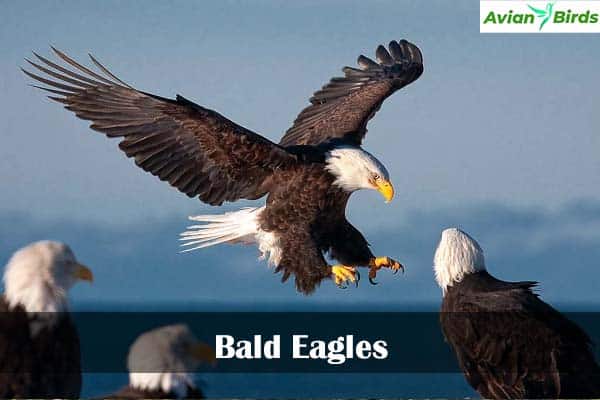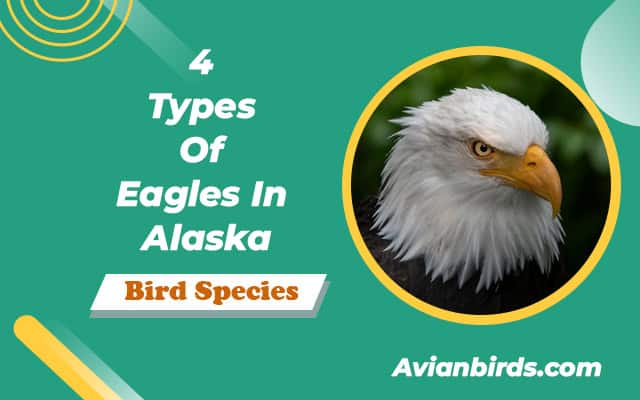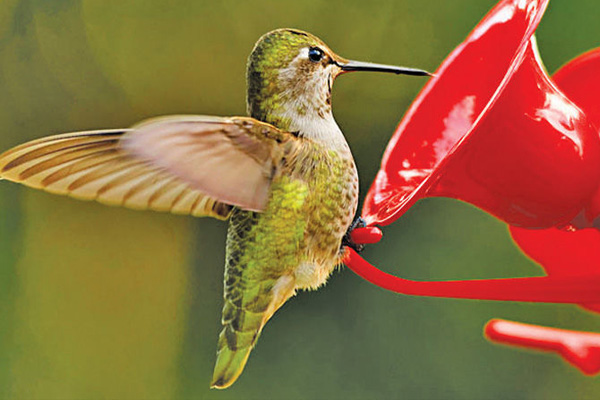4 Types Of Eagles In Alaska (With Pictures)
Ever wondered which eagles fly over in Alaska? Alaska, being the northernmost U.S. state, is a top spot for eagle fans. It has a wide variety of these iconic birds. From the Bald Eagle to the rare Steller’s Sea Eagle, Alaska’s eagles amaze nature lovers and adventurers.
But what makes these eagles special, and where can you find them in Alaska’s wild? Get ready for an exciting trip through Alaska’s land of the midnight sun. We’ll look into the unique traits, homes, and protection of Alaska’s eagles.
Eagles In Alaska
In North America, four eagle species live in Alaska: the Bald Eagle, Golden Eagle, White-tailed Eagle, and Steller’s Sea Eagle. These are the biggest birds in the state, known for their large wings and hunting skills.
About 30,000 Bald Eagles live in Alaska, with over 500 in the Copper River Delta. This is more than all the lower 48 states combined, which have 40,000 to 50,000 birds. Bald Eagles lay two eggs and have a wingspan of 7 ½ feet. They weigh 10-12 pounds, with some reaching up to 16 pounds.
The Golden Eagle, White-tailed Eagle, and the rare Steller’s Sea Eagle also call Alaska home. These eagles can be seen flying over the state’s wild landscapes, hunting with great skill.
Alaska is home to a diverse eagle population, showing the state’s rich natural heritage. These birds are key to the ecosystem and inspire awe in everyone who sees them.
1. Bald Eagle
- Scientific name – Haliaeetus leucocephalus
- Lifespan – 20 years (average)
- Size – 71 to 96 cm
- Weight – 3000 to 6300 g
- Wingspan – 180 to 220 cm
- Status – Least concern
The Bald Eagle is a majestic bird of prey. It has a white head and tail against its dark brown body and wings. This bird is the national symbol of the United States. Its recovery is a great conservation success story.

Physical Description
Adult Bald Eagles have a large, powerful bill and intense yellow eyes. They also have strong yellow legs and feet. Their claws are sharp and black. Young eagles are mostly dark brown with white mottling on their wings. Adults get their white head and tail feathers at four to five years old.
Nesting
Bald Eagles build their nests in tall trees, cliff ledges, or the ground. They line their nests with moss, grass, lichen, feathers, or cornstalks. They often reuse the same nest every year, adding more material each year.
Diet
Bald Eagles mainly eat fish like salmon, herring, catfish, and shad. But they also eat reptiles, birds, amphibians, crustaceans, and small mammals. They hunt both live prey and carrion, showing their adaptability.
Conservation Status
The Bald Eagle has made a big comeback from being endangered. Over the past five decades, their numbers have grown by almost 4% each year. Now, there are about 200,000 breeding pairs in the United States. This success comes from banning DDT and reducing persecution, helping the population grow again in the late 1900s.
Where to Find Bald Eagles in Alaska
Bald Eagles live in Alaska, especially in forests near lakes and big waters during breeding season. They also visit human areas when food is easy to find, like at dumps or fish factories. The most eagles can be seen in Alaska from September to May, with up to 30,000 birds there.
2. Golden Eagle
- Scientific name – Aquila chrysaetos
- Lifespan – 23 years (average)
- Size – 70 to 84 cm
- Weight –3000 to 6125 g
- Wingspan – 185 to 220 cm
- Status – Least concern
The Golden Eagle is a stunning raptor with a unique look. It has dark brown feathers, a golden nape, and pale flight feathers. Its blue-grey bill, golden-yellow eyes, and yellow feet with black claws make it stand out. Young Golden Eagles are mostly dark brown with white feathers on their tails and bases of primary feathers.

Physical Characteristics
Golden Eagles are huge, with wings up to 7 feet wide and weighing up to 12 pounds. They are powerful hunters, taking down prey from small mammals to large animals like deer and swans.
Nesting
Golden Eagles nest on cliffs and in various environments like shrubland and forests. They sometimes nest on the ground, in trees, or on man-made structures. Their nests are made of sticks and plant materials, sometimes using antlers and wire. They line their nests with grasses and other materials.
Hunting Techniques
Golden Eagles eat a variety of prey, mostly small to medium mammals. They also hunt larger animals like deer and mountain goats. They will eat carrion too. This makes them opportunistic predators.
Conservation Efforts
The Golden Eagle has a stable population of 130,000 breeding pairs. But, they face threats like trapping and poisoning, causing about 70% of deaths. Collisions with vehicles and wind turbines are also dangerous. Laws protect them, ensuring efforts to keep this species safe.
3. White-tailed Eagle
- Scientific name – Haliaeetus albicilla
- Lifespan – 21 years (average)
- Size – 66 to 94 cm
- Weight – 3500 to 7000 g
- Wingspan – 178 to 245 cm
- Status – Least concern
The White-tailed Eagle is a huge raptor with dark brown feathers. Its head and body are lighter brown, and its tail is white. It has a big, yellow bill, legs, and eyes, with black claws. Young birds have brown feathers, a white-streaked tail, and a dark bill. They make a loud krick-rick-rick-rick-rick call.

Nesting
These eagles nest on sea cliffs and tall trees. They put their nest on a rocky ledge or near the tree trunk. The nest is made of sticks and branches and is lined with moss and other materials. The female lays two to four dull white eggs, which she incubates for 34 to 46 days.
Diet
The White-tailed Eagle eats fish, waterfowl, and small mammals. They are opportunistic and will steal food from other birds, like sea otters and ospreys.
Range
You can see a White-tailed Eagle in Alaska off the coast of the Aleutian Islands. It’s sometimes seen as a vagrant from east Russia. These eagles are more common in Europe and Asia.
4. Steller’s Sea Eagle
- Scientific name – Haliaeetus pelagicus
- Lifespan – 20 years (average)
- Size – 85 to 105 cm
- Weight – 4900 to 9500 g
- Wingspan – 195 to 245 cm
- Status – Vulnerable
The Steller’s Sea Eagle is a huge raptor with a big yellow-orange beak. It has brown feathers and white patches on its belly, tail, and more. Its eyes and feet are bright yellow, and it has black claws.

Juvenile birds look darker with lighter patches. This makes them easy to tell apart from adults.
Nesting
Steller’s Sea Eagles build their nests near rivers, lakes, coastlines, or cliff ledges. They make big stick nests in trees or on cliffs. A pair often comes back to the same nest every year.
The female lays one to three greenish-white eggs. These eggs hatch in 38-45 days.
Diet
Steller’s Sea Eagles love to eat fish, like salmon and trout. They also eat seabirds, small mammals, and carrion sometimes.
Sightings and Locations in Alaska
These eagles don’t live in Alaska often, but they sometimes come from Russia. People have seen them in places like Saint Paul Island and Saint George Island. They’ve also been spotted in Unimak Island, Kodiak Island, and Attu Island.
Other places they’ve been seen include Amchitka Island, Dillingham, King Salmon, Lower Noatak River, and Taku Inlet.
Check Our Previous Articles:
Best Birding Destinations for Eagles In Alaska
Alaska is a top spot for eagle lovers, with many places to see these amazing birds. The Chilkat Bald Eagle Preserve is famous for having the most Bald Eagles in one spot. Kenai Fjords National Park and Denali National Park also offer great chances to see eagles.
The Copper River Delta, Juneau Mendenhall Wetlands, and Mendenhall Wetlands State Game Refuge are great for eagle sightings. If you’re starting your trip in towns like Anchorage, Fairbanks, Nome, Homer, Gustavus, or Ketchikan, you’re in good shape. The coastal islands, like Saint Paul Island, Gambell, and Kodiak Island, are also great for bird-watching.
If you want to see Bald Eagles, Golden Eagles, White-tailed Eagles, or Steller’s Sea Eagles, Alaska has it all. With its many national parks, wildlife refuges, and birding spots, your eagle-watching trip will be memorable.
Frequently Asked Questions:
Q1. What kind of eagles live in Alaska?
Bald eagles and golden eagles live in Alaska.
Q2. What city in Alaska has the most eagles?
Haines, Alaska, has the most eagles.
Q3. Why are there so many eagles in Alaska?
Alaska has many eagles because it has plenty of food and good habitats.
Q4. Can you see eagles in Alaska?
Yes, you can see eagles in Alaska.







